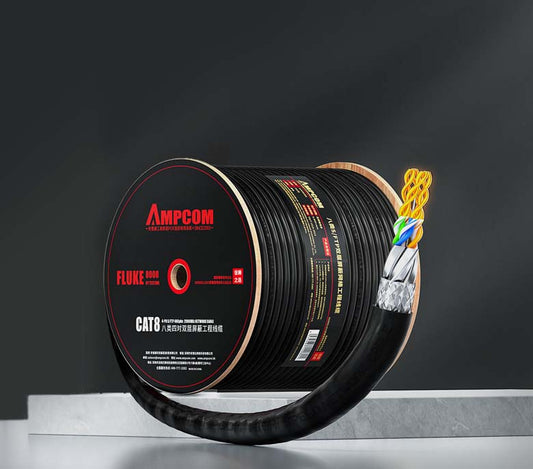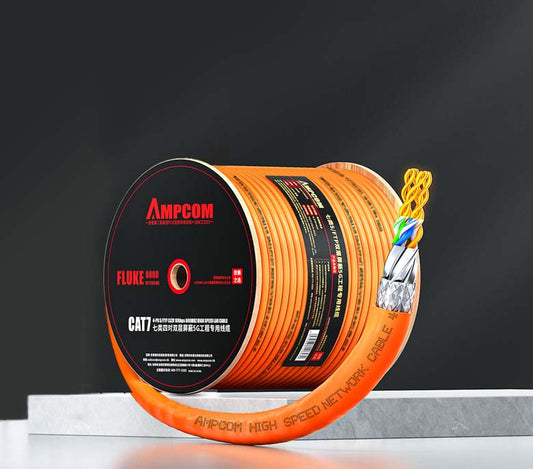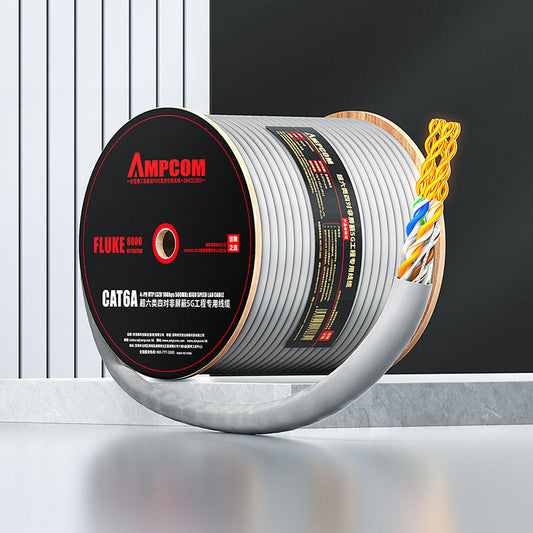From Twisted Pair to Data Centers: The Evolution of Patch Cord Categories and Their Synergy with Data Center Architecture
Introduction
Data centers, as the "heart" of the modern digital economy, handle the storage, processing, and transmission of massive amounts of data. The intricate network architecture within them, like a sophisticated neural network, ensures the smooth flow of information. Among these architectures, the seemingly unassuming network patch cords are the crucial blood vessels connecting the various "neurons" (servers, storage, switches). From the earliest simple Cat5e patch cords to today's Cat8 patch cords carrying 40G/100G high-speed connections, the evolution of patch cord categories is not merely an upgrade in technical parameters but a closely coordinated and co-evolving process with the overall data center architecture design, performance requirements, and management strategies. This article will delve into this synergy, revealing how patch cord categories have changed with the development of data centers and how they, in turn, influence data center architecture decisions.

1. The "Capillaries" of Early Data Centers: The Cat5e Patch Cable and Cat6 Patch Cable Era
In the early stages of data center development, network traffic was relatively manageable, with applications primarily focused on file sharing, email services, and basic web hosting. At this time, Cat5e and Cat6 patch cords were the absolute mainstream.
The Cat5e "Enlightenment": Cat5e (Enhanced Category 5) patch cords support a maximum transmission rate of 1 Gbps. After the publication of the Gigabit Ethernet standard (IEEE 802.3ab), it became the foundation for many early data center internal connections and horizontal cabling. Its relatively low cost and ease of installation were sufficient to meet the needs of most applications at the time. Structurally, Cat5e followed the Cat5 design, using four pairs of 24 AWG copper conductors twisted together to reduce crosstalk. Inside the data center, it was often used to connect servers to rack-mounted switches or to connect smaller network devices. During this period, patch cord management was relatively simple, typically using basic labels and zip ties for differentiation.
Application and Customized Design of Cable Tracers in Specific Industries
The Cat6 "Proliferation": As data center applications gradually became more complex, such as database applications, the initial application of virtualization technology, and video conferencing, the demand for network bandwidth and stability began to increase. Cat6 patch cords emerged, supporting up to 1 Gbps to 100 meters and 10 Gbps over short distances (typically within 55 meters). Cat6 patch cords usually have a central cross-piece separating the four pairs of wires, further reducing crosstalk between pairs and improving performance margin. In data center architecture, the proliferation of Cat6 enabled 10 Gbps Ethernet to begin entering the data center's interior, especially in short-distance connections between servers and core switches. This drove some architectural changes, such as denser server deployments and the adoption of faster storage networks (like iSCSI) using Ethernet as the underlying transport. Patch cord management became increasingly important because higher density meant easier errors, requiring clearer identification and more organized routing. The architecture was mostly a layered structure (core, aggregation, access layers). Patch cords primarily played a point-to-point connection role. Architectural design focused more on switch port density, backplane bandwidth, and routing protocols. The choice of patch cord category was more based on cost and current application needs, having relatively limited influence on shaping the overall architecture. However, Cat6's support for 10 Gbps laid the foundation for the evolution of subsequent higher-speed network architectures.

2. 10 Gigabit Proliferation and Architectural Transformation: The Rise of Cat6a
With the rise of cloud computing and big data analytics, data traffic within data centers has grown exponentially. The widespread adoption of server virtualization, large-scale VM migrations, and storage I/O-intensive applications have all demanded 10 Gigabit (10 Gbps) or even higher bandwidth. At this point, Cat6a (Augmented Category 6) patch cords became a key driver for data center architecture upgrades.
Cat6a's "Responsibility": Cat6a patch cords increase the transmission frequency to 500 MHz, for the first time enabling stable full-duplex 10 Gbps Ethernet over 100 meters. To achieve this performance, Cat6a typically uses thicker 23 AWG conductors, tighter pair twists, and may employ more robust central cross-pieces or fillers to further isolate pairs and reduce crosstalk. Its physical size is larger than Cat6. The appearance of Cat6a allowed 10 Gbps Ethernet to be deployed on a large scale throughout data centers, not just from servers to core switches, but also from servers to access layer switches, and even for some storage connections.
Architectural Synergy: The widespread adoption of Cat6a profoundly impacted data center network architecture.
- Flattened Networks: To reduce latency and costs associated with network layers, data centers began adopting more flattened network architectures, such as Leaf-Spine (Leaf-Spine) architecture. In this architecture, a large number of servers connect directly to Leaf switches, which are then interconnected via high-speed Spine switches. This architecture inherently requires a large number of 10 Gbps or higher speed connections, making Cat6a patch cords the infrastructure for implementing this architecture. Its 100-meter transmission distance also makes more flexible rack layouts possible.
- High-Density Deployment: The high bandwidth supported by Cat6a made it possible to deploy more servers within a single rack, increasing rack power density and cooling challenges. This, in turn, requires network architecture design to carefully consider port density, power distribution, and cooling efficiency.
- Unified Networking: The popularity of Cat6a also accelerated the trend of "unified networking" in data centers, using Ethernet to carry storage, computing, and other types of traffic, simplifying network management. This requires the network architecture to be more flexible and scalable.
Patch Cord Management Challenges: With the dramatic increase in the number and density of patch cords, patch cord management became more important and complex than ever. Cat6a patch cords are thicker, making cabling space tighter. Data centers began widely adopting systems like patch panel labeling, patch cord managers (Patch Panel Managers), color coding, and even barcode/RFID-based automated patch cord management systems to ensure traceability and rapid troubleshooting. Patch cords are no longer just "connection lines" but have become a key element in network asset management and operational efficiency.

3. Extreme Performance and Short-Distance Connections: The Debut of Cat7 and Cat8
After 10 Gbps became the standard configuration in data centers, the demand for even higher performance did not stop. Artificial intelligence training, high-performance computing (HPC), and high-speed interconnects within ultra-large-scale data centers have driven the evolution of patch cord categories towards Cat7 and Cat8.
Cat7's "Strengthening": Cat7 patch cords increase the frequency to 600 MHz and introduce a fully shielded design (individual pair shielding FTP/SFTP + overall shield S/FTP). This design significantly improves resistance to electromagnetic interference (EMI), making it particularly suitable for interference-prone industrial environments or high-density data centers. Cat7 supports 10 Gbps up to 100 meters (using specific connectors) and 40 Gbps over short distances (25 meters). Its shielding characteristics require the connectors to also be shielded and properly grounded during installation. Cat7 is not a TIA/EIA standard but is defined in an amendment to ISO/IEC 11801.
Cat8's "Leap": Cat8 patch cords significantly increase the frequency to 2000 MHz (2 GHz), primarily targeting 25 Gbps and 40 Gbps high-speed applications. Their transmission distance is shorter, typically 25 meters or 50 meters. Cat8 patch cords also employ strict shielding designs (mostly S/FTP or SSTP) and are optimized for high-density, short-distance connections. Cat8 is defined by the TIA-568.2-D standard as the latest category and is currently the mainstream choice for implementing 40Gbps Ethernet connections within data centers.
Architectural Synergy: The emergence of Cat7, especially Cat8, enables data centers to deploy network architectures based on 40 Gbps, and even 100 Gbps (through specific technologies like MLOMMA), supporting even flatter, higher-speed network designs, such as large-scale Leaf-Spine architectures, as well as finer-grained network partitioning and isolation. For example, providing dedicated high-speed network channels for AI training clusters or HPC clusters. Standards and Specifications: Installation Practices and Acceptance Criteria for Cat5e to Cat8 Patch Cables
- Modular and Prefabricated Data Centers: The high cost of high-speed patch cords (especially Cat8) and the requirements for installation precision have also promoted the development of modular and prefabricated data centers. In these data centers, network cabling (including patch cords) may be pre-fabricated and tested in a factory environment before being transported to the site as a complete module for installation. This improves deployment speed and reliability but also imposes higher requirements on patch cord selection and pre-configuration.
- Extension to Edge Computing: With the development of edge computing, some edge sites with extremely high requirements for latency and bandwidth have also begun to use Cat7 or Cat8 patch cords to build internal high-speed networks, while the connection to the central data center may be through fiber or other media.
Patch Cord Management at its Peak: In the Cat7/Cat8 era, patch cord management became more sophisticated and systematic.
- Shield Grounding Systems: The shielding performance of Cat7 and Cat8 depends on a complete grounding system. Data centers need to design a dedicated grounding architecture to ensure that all shielded patch cords, patch panels, racks, and equipment are reliably grounded, forming a low-impedance equipotential body.
- High-Density Cabling Techniques: While powerful, Cat8 patch cords pose challenges for high-density cabling due to their physical size and short-distance characteristics. Data centers need to adopt more advanced cabling techniques, such as vertical cable trays, optimized patch panel designs, and more efficient patch cord managers, to accommodate large numbers of patch cords while maintaining smooth airflow.
- Automation and Intelligence: Patch cord management systems are no longer just static labels and records but are increasingly integrated with CMDB (Configuration Management Database) and network monitoring systems, enabling real-time status monitoring of patch cords, automated recording of changes, automatic fault location, and even predicting potential problems through AI. Patch cord management is moving towards intelligent operations and maintenance.

4. Drivers for the Evolution of Patch Cord Categories and Future Trends
The evolution of data center patch cord categories is driven by multiple factors working together:
- Application Demand Pull: Whether it's the massive data transmission brought by cloud computing or the demand for extreme computing and communication capabilities by AI/HPC, these are the fundamental drivers for increasing network speed.
- Technological Standard Push: The continuous upgrading of IEEE Ethernet standards (from 1G to 10G, 25G, 40G, 100G) and the updates to cabling standards from TIA/EIA, ISO/IEC, etc., provide the basis and assurance for the design and application of higher-performance patch cords.
- Cost-Benefit Considerations: While high-end patch cords like Cat8 are expensive, the performance improvements and efficiency gains they bring in high-density, high-performance scenarios may far outweigh the initial investment. Data centers need to find a balance between performance, cost, and future scalability.
Looking ahead, data center patch cord categories may show the following trends:
- Higher Frequencies and Rates: As optical module costs decrease and integration improves, Ethernet standards for even higher speeds (such as 200G, 400G, and even 1T) will accelerate their implementation. Corresponding categories like Cat8.1, Cat8.2, or even higher categories (potentially featuring further innovations in structure and materials) may emerge to meet the demand for ultra-high-speed connections over shorter distances (such as within chassis or within racks).
- Copper and Fiber Coexistence: For extremely high speeds (like 400G and above) and long-distance transmission, fiber optics still have irreplaceable advantages. In the future, data center interiors are likely to form a coexistence situation where copper (for medium/short-distance, high-density connections) and fiber (for long-distance, extremely high-speed connections) work together. Patch cord designs may also emerge with hybrid or transition solutions between copper and fiber.
- Intelligence and Self-Healing Capabilities: Patch cords themselves may incorporate more intelligent elements, such as optical switches in fiber patch cords or signal quality monitoring chips in copper patch cords, enabling them to self-diagnose and even participate in network automatic reconfiguration and fault recovery.
- Green and Sustainable: The application of new environmentally friendly materials and more optimized designs to reduce energy consumption (such as lowering signal attenuation) will also be important directions for the future development of patch cords.
-
From "Chaos" to "Order": The Importance and Best Practices of Data Center Cable Management

Conclusion
From Cat5e Patch Cable to Cat8 Patch Cable, the evolution of network patch cord categories is a microcosm of data center technological advancement. It not only reflects the leap in network transmission speed but also profoundly embodies the evolution of data center architecture from simple to complex, from layered to flattened, and from low-speed to ultra-high-speed. Patch cords are no longer just passive infrastructure components but have become key elements closely coordinated with data center architecture design, application requirements, and operational management, mutually reinforcing each other. Understanding this synergy is crucial for designing, building, and operating an efficient, reliable, and future-ready data center. As technology continues to develop, these "capillaries" will continue to evolve, delivering stronger "blood" to the "heart" of the data center.



